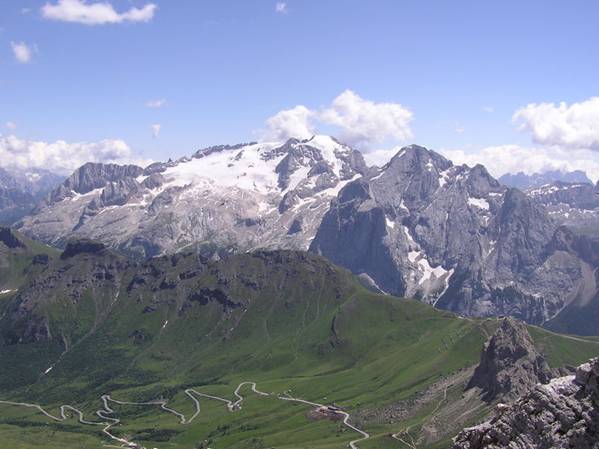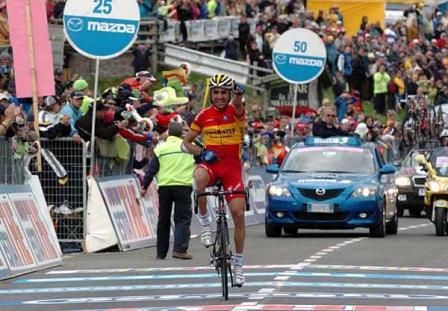CyclingRevealed's Giro 06 Perspective
Tappa 19, May 26th,
Pordenone to Passo di San Pellegrino, 224 km
Know your 'Marmolada' from your 'Fedaia'
The Tour de France has the Alps and Pyrenees while the Giro has the Alps and the Dolomites. Each mountain range has its own distinct character and the Dolomites are distinguished by mighty limestone spires, very long climbs and contain the highest passes in Europe. In fact the Stelvio Pass which is frequently used by the Giro (but not this year) is the highest.
The Dolomites are in fact a section of the Alps and they are located in equal parts in the provinces of South Tirol, Belluno and Trentino (all in northern Italy) and extend from the Adige River in the west to the Pieve valley (Pieve di Cadore) in the east. In this part of the world there is no clear delineation between Italy and Austria from a cultural point of view. Over many centuries the border has moved north and south depending on the political and military powers of the time. Consequently the visitor may be confused as the (Austrian) German and Italian languages are used in equal measure. To complicate matters there are also local dialects which have roots in both languages as well as a sprinkling of the Latin and Romanesque languages. For cycling fans this blend can create misunderstandings. A couple of stages ago the race descended the Sempione Pass. To English speakers this same pass is known as the Simplon. Two and sometimes three names for the same mountain or pass are not uncommon.
The Giro typically maximizes its stay in the Dolomites as it weaves a sinuous path from valley to valley tackling numerous incredible climbs. Today the race took in four major climbs with mercifully in warm and sunny weather. Midway through the day the race climbed the Passo Fedaia (2057m). Some people erroneously also call it the Marmolada. The Marmolada is not a pass but rather the highest of the Dolomite peaks at 3,343m and is commonly known as the “Queen of the Dolomites”. The Fedaia (as does the Pordoi) winds across the Marmolada and from the road there are spectacular views of the “Queen” and her famous glacier field.

The Marmolada and its glacier looms over the Passo Fedaia and the Passo Pordoi
Yesterday's announcement that Liberty Seguros had withdrawn its sponsorship of the team following the arrest of DS Manalo Saiz on drug related charges caused considerable confusion. Saiz was released from custody and is saying that he will continue to manage the team this year. The remaining Liberty Seguros riders in the Giro unexpectedly signed on today and hopefully they will continue until Milan .
While the storm raged around the Liberty story the Giro got under way. Before reaching the first climb Paolo Bettini went hard at the Gazetta sprint to try and secure his lead in the Points Classification. The impetus of the sprint resulted in 19 riders forming a break that included Bettini. Together they hit the first climb of the 12km long Forcella Staulanza (6.8% average). As did the peloton over five minutes behind them, the break fragmented up the climb resulting in smaller groups descending from the climb. The road now headed straight for the feared Passo Fedaia with ramps of 18% along its 14km path. Unlike many passes the Fedaia starts with long steep strength sapping straights and then towards the top culminates in back breaking hairpin bends. Getting up the whole thing is as much a psychological challenge as a physical one. Many may have been surprised to see Bettini leading for most of the climb but amongst his many accomplishments the Olympic RR Champion has also worn the mountains jersey for a while at the TdF.
With the huge Marmolada Glacier glinting in the sun the break topped the Fedaia as the much diminished bunch closed to about four and half minutes behind them. Surprisingly Danilo Di Luca had slipped into the break but being 18min 27secs back on GC this was of little concern to CSC (but it did cause some consternation with Saunier Duval who was jealously protecting their team lead).
Surrounded by snow speckled peaks the riders put on additional clothing for the long descent from the snow line and back down to lush forests in the valley. After the bleak weather of recent days it was wonderful to see the peloton basking in sun as it raced through some of the most breathtaking scenery in Europe .
As a result of Basso's commanding lead on GC the race was developing with less drama than would be hoped for on a day like this. The main action focused on the mountain jersey (GPM) which at that point was held by Basso. Fortunato Baliani (Ceramica) who was in the break was within grasping distance of the jersey. Consequently he attacked at the top of both the Staulenza and Fedaia climbs to amass maximum points.
As the leaders started to head up the Passo Pordoi (11km, 6.8% average) the race for GC had already settled into becoming a lame affair. Jens Voigt and Bobby Julich were in the break looking after Basso's interests. While back in the small bunch Basso had nobody to really challenge him. Even so CSC decided to reduce the breaks advantage and Julich was sent back to join forces with the rest of the team.
Still within close proximity to the Majestic Marmolada, the break ground its way up the Pordoi while behind them CSC put some urgency into the chase. Despite Basso's advantage too much complacency could be dangerous. Mountains are notorious for suddenly reversing fortunes.
Baliani was now driving the break in his quest for the mountains jersey. Bettini was dropped from the break, his work done for teammate Juan Garate who was considered the prime candidate to take the stage so long as the break kept ahead of the bunch. At the top of the Pordoi Baliani took the prime and with it assumed ownership of the GPM jersey. Just over three minutes later a small group containing Bettini and Julich crested while Basso and the bunch were a further 3mins behind them.
In 1948 this climb had seen a very different situation. Fausto Coppi quit the race that year in protest at the pushes his rivals were getting on the Pordoi. The following year Coppi wreaked vengeance and tore the race apart on the climb on his way to the third of his five Giro victories. Today few people noticed the monument to Coppi at the top of the Pordoi.
After a long, long descent the race now headed for the final very difficult 18km climb, 6.2% average with 15% ramps, up to the Passo Di San Pelligrino mountain top finish. Saunier Duval took over from CSC but the gap to the break was still over six and half minutes.
Eleven surviving members of the break started the final climb together. Like fire crackers individual riders suddenly shot away from the break. Jens Voigt (Team CSC), Tadej Valjavec (Lampre-Fondital) solidified an advantage quickly. As the powerhouse of CSC, Voigt is normally more at home setting leg ripping tempos along flatter terrain. Suddenly Garate rejoined the two leaders and the increased tempo promptly dispatched Valjavec backwards.
Meanwhile Piepoli was driving the peloton hard for his Saunier Duval team leader Simoni. The plan was to ease Simoni ahead of Gutierrez to grab second on GC. As this was happening poor Savoldelli faltered and then clawed his way back before dropping back again.
Simoni hit the front then Piepoli took over with an effort that destroyed the remains of the bunch. Most importantly the team tactic cracked Gutierrez and he slipped agonizingly back. Simoni took the lead again and now it was just him and Basso as Cunego, about 100m back, tried desperately to hook on.
Two terrific mano-a-mano struggles now dominated the final act. The incredible Voigt was demonstrating the breadth and depth of his amazing talent as he spoke to Riis on his race radio coming into the finish. Nobody would have bet on this man contesting the finish of this magnificent mountain stage. If nothing else cycle racing always delivers surprises. As the two of them approached the last two hundred meters Voigt suddenly sat up and patted Garate on his back. The two shook hands and Garate then rode ahead to take the much deserved win.

Stage winner Juan Garate [ Image ©: www.gazzetta.it ]
Nearly three minutes back the proud former Giro winner Simoni was driving hard to put as much time as possible into Gutierrez. He certainly closed the gap but he still has a long way to go. The challenge is feasible but improbable with just one day of climbing left.
Elsewhere the long day of climbing created carnage and there was considerable jostling of places on the GC table. Tomorrow another day of extreme climbing will be crowned with the “Cima Coppi” as the weary bunch heads up over the legendary Gavia Pass.
After more than seven hours in the saddle the last 6kms averaging 9% and maxing out at 15% put some serious pain into a lot of riders. To be sure the combination of scenery, weather and powerful racing made for a great day out for race fans lining the roads. “The Queen of the Dolomites” basking in sun watched regally but impassively as the Giro challenged her subjects, the Passo Fedaia and Passo Pordoi. Such dramatic surroundings deserved considerably more race drama. Today saw some terrific racing but in the grand scheme of things it will not distinguish itself in the Giro history books.
Tomorrow: another fearsome day of climbing as the Giro scales its highest climb and this years “Cima Coppi”, the legendary Passo Gavia. Also on tap is the greatly feared Passo Del Mortirolo which is considered to be one of the toughest climbs in all of cycling. Check back tomorrow for our report on the 212km stage from Trento to Aprica.
Return to Giro 06 ToC >>> Previous Stage >>> Next Stage >>> |
